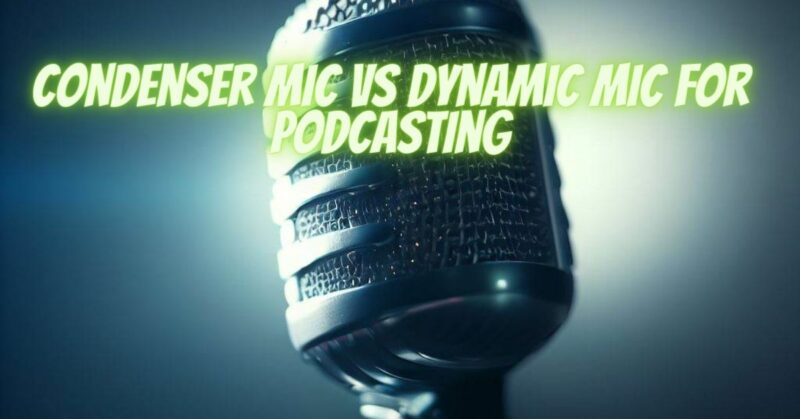When it comes to podcasting, selecting the right microphone is essential for capturing clear and professional-quality audio. Condenser microphones and dynamic microphones are two common options available, each with its own characteristics and suitability for podcasting. In this article, we will compare condenser mics and dynamic mics for podcasting, helping you make an informed decision based on your specific podcasting needs.
Condenser Microphones:
- Sensitivity and Detail:
Condenser microphones are highly sensitive and capture a wide frequency range, making them ideal for capturing the subtle nuances in spoken vocals. They excel at capturing the full spectrum of human voice, ensuring clarity and detail in podcast recordings. Condenser mics are well-suited for capturing the nuances of speech, vocal inflections, and delicate sounds.
- Studio Environments:
Condenser microphones are commonly used in controlled studio environments. They are ideal for podcasters with dedicated recording spaces or home studios where ambient noise can be controlled. In a controlled environment, condenser mics deliver transparent and professional-quality sound.
- Phantom Power Requirement:
Condenser microphones require phantom power, typically provided by an audio interface or mixing console. Ensure that your recording setup includes phantom power capabilities to power the condenser mic.
Dynamic Microphones:
- Durability and Versatility:
Dynamic microphones are known for their durability and ability to handle high sound pressure levels. They are less sensitive compared to condenser mics, making them suitable for recording in less controlled environments where ambient noise is a concern. Dynamic mics can handle more challenging recording situations and are less prone to capturing background noise.
- Off-Axis Rejection:
Dynamic microphones have excellent off-axis rejection, meaning they primarily capture sound from the front and minimize unwanted background noise. This makes them suitable for recording in noisy environments or situations where there may be multiple podcast participants.
- Portability:
Dynamic microphones are often more rugged and compact, making them ideal for podcasters who need to record on the go or in different locations. They are less sensitive to handling noise and can withstand the rigors of travel.
Choosing the Right Mic for Podcasting:
- Recording Environment:
Evaluate the recording environment for your podcast. If you have a controlled studio setup or a dedicated recording space, a condenser microphone can deliver the highest level of detail and clarity. If you record in various locations or have limited control over ambient noise, a dynamic microphone may be more suitable.
- Number of Participants:
Consider the number of podcast participants. If you have multiple people speaking simultaneously, a dynamic microphone with good off-axis rejection can help minimize cross-talk and background noise. For solo podcasting or situations where only one person is speaking at a time, a condenser microphone can capture the nuances of the voice effectively.
- Budget and Portability:
Consider your budget and portability requirements. Dynamic microphones tend to be more affordable and robust, making them suitable for podcasters on a budget or those who need a portable setup. Condenser microphones, while typically more expensive, offer superior sensitivity and detail for high-quality studio recordings.
| Feature | Condenser Microphone | Dynamic Microphone |
|---|---|---|
| Sensitivity | More sensitive | Less sensitive |
| Frequency Response | Wider frequency range | Narrower frequency range |
| Power Requirements | Requires phantom power | Does not require phantom power |
| Durability | Less durable | More durable |
| Price | More expensive | Less expensive |
| Ideal Uses | Vocals, acoustic instruments, classical instruments | Interviews, podcasts, live performance |
Conclusion:
Choosing the right microphone for podcasting involves considering factors such as the recording environment, number of participants, budget, and portability requirements. Condenser microphones are ideal for controlled studio environments and capturing the nuances of the spoken voice. Dynamic microphones are more versatile, durable, and suitable for on-the-go or less controlled recording situations. By understanding the characteristics and strengths of condenser mics and dynamic mics, you can select the microphone that best suits your podcasting needs and ensures clear, professional-quality audio recordings for your listeners.


